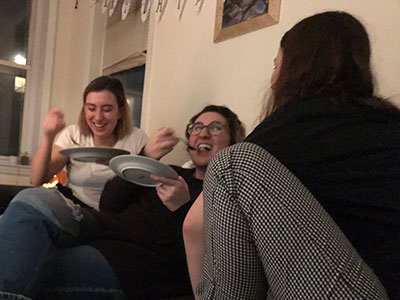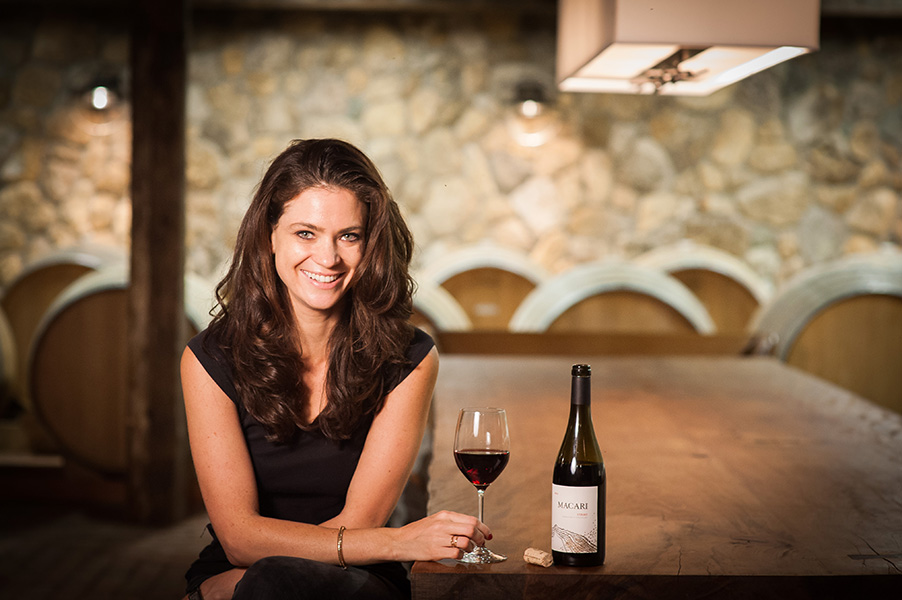For many, Thanksgiving signifies the start of the holiday season. The meal-planning frenzy begins, as do the plans to see loved ones and enjoy some hard-earned time off.
Below are some tips, ideas, and time-honored traditions from members of the Fordham community to help make the holiday fun, restorative, and as stress-free as possible.
Gratitude for Family—‘the Greatest Blessing’
Thanksgiving brings with it the chance to reflect on our blessings, and chief among them is family, said Joseph M. McShane, S.J., president of Fordham.
“I find myself singing ‘We Gather Together’ often in the course of the day,” said Father McShane, referring to the traditional Thanksgiving hymn. “Moreover, as the ordained member of my family, I lead grace at our Thanksgiving dinner. Prior to offering the prayer, I ask my family to spend a few moments in silent prayer reviewing all of the graces and blessings that they have experienced in the course of the year (and in the course of their lives), with special emphasis on the people God has brought into our lives. We dwell in that moment and savor the rich memories we all have of those who used to be with us around the Thanksgiving table. Then we pray in a formal way and toast our parents, grandparents, aunts, uncles, brothers, and sisters—the greatest blessing that God sent us.”
Friendsgiving Dinners
For those who find themselves without plans for a big Thanksgiving dinner, or for those who’d like to squeeze in an extra one and meet some new people in the process, Fordham student entrepreneurs have got you covered.
Gabelli School students Joseph Zoyhofski, Liam Scott, Alex TenBarge, and Emily Lehman founded a meal-sharing platform called the Provecho Project, after the Spanish phrase buen provecho which roughly translates to “enjoy your meal.”

The site works by allowing users to advertise a meal they’d like to make at home, and how much they plan to charge for it. Those interested can sign on, and the site charges a small processing fee on top of the price of the meal.
Last year, the group staged its first “Friendsgiving,” in which a provecho, or meal, was held every day for the week leading up to Thanksgiving. With a new website up and running, Zoyhofski said they’re excited to stage Friendsgiving again this year, from Nov. 21 to 27.
The meals have primarily attracted students, although they are open to all members of the Fordham community. To join a meal, visit their website.
A Holiday Classic: Julia Child’s Chocolate Mousse
When it comes to Thanksgiving dessert, most people expect a table full of pies. But one Fordham employee whips up something different each year: homemade chocolate mousse.
“My husband’s a real chocoholic, so I always have to have something chocolate for him for dessert,” said Patricia Wolff, a Fordham financial aid counselor. “I started making it 30 years ago, and it’s delicious.”
The recipe—originally created by acclaimed chef Julia Child—calls for a quarter cup of dark-brewed coffee. Wolff said she adds two shots of hot espresso, used to melt the chocolate.
Besides being delicious, the dessert is convenient.
“You make it the day before, so it just sits in the fridge,” Wolff said. “There’s always too much going on in the oven, so that’s another good reason to have this for Thanksgiving.”
Finding the Right Wine

For those looking for the perfect Thanksgiving wine, Gabriella Macari, GABELLI ’09, of Macari Vineyards in Mattituck on Long Island, reminds everyone that, “the first rule of wine pairings is that there are no rules.”
Still, she had a few pieces of advice for those looking for the perfect bottle.
“Traditional Thanksgiving pairings include wines that pair with turkey such as light-bodied reds; Pinot Noir, Cabernet Franc, and Gamay are great choices,” said Macari, a certified sommelier.
While many people continue to serve red with dessert, Macari recommends switching to a sparkling wine. Finding a wine with meaning can also make it taste that much sweeter.
“Holiday wines should be delicious and can be even better if they mean something to you,” Macari said. “For us, for example, opening an old vintage of one of our wines to share with friends and family is very meaningful and evokes strong emotion.”
Macari also encouraged people to shop local wines for the American holiday.
“American wines are now better than ever,” she said.
Prioritizing Wellness
When everyone’s done with dinner, dessert, and libations, the living room couch beckons. But some families are looking for more ways to stay active and burn a few of those extra calories.
“Consider a Turkey Trot on Thanksgiving morning,” Jeanne Molloy, wellness manager at Fordham, said. “These 5Ks have grown in popularity and can be walked in 45 to 60 minutes if you haven’t trained to run it. That morning outing will help boost your metabolism all day.”
A post-walk dinner with the dogs can also be a way to stretch the legs and make your pets happy, Molloy said.
Sarah Bickford, the administrator of fitness and recreation at the Ram Fit Center, said physical activity can have the added benefit of helping to ward off any holiday blues.
“The holidays can also be a stressful time for people,” she said. “Exercise or group activities can be a great way to help people relax, come together, and feel better.”
Handling Stress
For some, stress will be inevitable. Jeffrey Ng, Psy.D., director of counseling and psychological services (CPS) at Fordham, offered advice on coping with challenging situations.
One of the more common concerns reported by students is balancing family time, self-care, and schoolwork over the holidays—especially right before final exams and project deadlines, said Ng. He advised students to proactively plan their time and identify their needs before break arrives, and to try to be transparent with family and friends about what’s on their plate.
Another common issue is interacting with family members or friends who have differing social or political beliefs, said Ng.
“The college years are a time of heightened identity formation and change, and a student’s emerging beliefs and perspectives may be diverging from their family of origin’s values and perspectives,” said Ng. “While it can be meaningful and growthful to figure out how to navigate potential tensions with family members, it’s also okay to opt out of some interactions or conversations that may feel particularly activating or overwhelming.”
For those who might be alone on Thanksgiving, try to find local opportunities to engage in community service and connect with friends, Ng said. And, he added, be careful with social media usage—too much scrolling may exacerbate feelings of social comparison, FOMO, and loneliness.
“The mind gravitates toward negative experiences and events so we need to intentionally practice gratitude,” Ng said. “The more we practice gratitude outside the context of holidays like Thanksgiving, the more we’ll be able to do so under more challenging circumstances.”
Books that Conjure Gratitude
With plenty of holiday time off and the cold winter months looming, Thanksgiving represents a good time to start plotting wintertime reading. Fred Nachbaur, director of Fordham University Press, said he’s grateful for a couple of recent reads.
Say Nothing: A True Story of Murder and Memory in Northern Ireland by Patrick Radden Keefe (Knopf Doubleday, 2019) is a reminder of darker times in Northern Ireland.
To be honest, I didn’t really know much about the IRA and their covert operations or those of the British government,” said Nachbaur.
The book begins with the abduction of a widowed mother of 10 living in public housing and goes on to give a detailed history of the “Troubles” and the cast of characters involved.
“It reads like a crime story—totally compelling and mind-blowing; I learned a lot,” he said. “We often forget about the more tumultuous times that make you appreciate the relative peace we enjoy here.”
Closer to home, Nachbaur said he is very grateful for Susan Greenfield’s oral history, Sacred Shelter: Thirteen Journeys of Homelessness and Healing (Fordham University Press, 2019). He noted that all of the contributors helped put life into perspective.
Nachbaur feels thankful for one essay in particular, titled “Reflection: Hope,” written by a social worker who worked with a group of formerly incarcerated individuals.
“The author opens up about her difficulty with being adopted and experiencing a deep sense of loss and not fitting in,” he said. She found healing in working through the anger that group members shared stemming from adoption and feeling abandoned by their parents.
“My daughter is adopted and this piece really helped me better understand her challenges,” said Nachbaur. “I am very grateful to the author,” he said.
Giving Beyond the Season of Giving
Every year around the Thanksgiving and Christmas holidays there’s an uptick in volunteering. But how can these seasonal volunteers carry the do-good spirit to the rest of the year?
Arto Woodley, Ed.D., executive director for the Center for Community Engaged Learning, said one way to connect with others is to connect with yourself first.
“First ask yourself, what is your passion in reference to engaging in communities, and why is it important to you?” said Woodley. Also, volunteers should consider whether they are looking for a one-time event or sustained involvement, he said.
And rather than reach out to organizations and ask when they need volunteers, Woodley suggests an “asset-based approach” that will help volunteers align their strengths with an organization’s strengths year-round. He suggests that “needs-based” volunteering will inevitably lead to “volunteer fatigue,” because there will always be a new need.
“This requires a paradigm shift from volunteering to engagement and building deeper relationships with organizations and community partners,” he said. “I definitely prefer the model where the organization and the volunteer build something constructive together.”
— Reporting by Taylor Ha, Kelly Kultys, Tom Stoelker, and Patrick Verel


